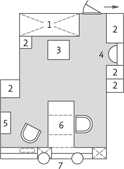|


Germany (1905)
|
Hans-Günther Busch was born on 26 November 1905 in Spandau. After graduating from high school, he studied medicine at college, graduated and was licensed to practice. Afterwards, he and his younger brother, Hans-Gerd, decided to become Naval doctors. Both were accepted started their basic training on 1 April 1932, joining Crew 1932. One part of their officer’s training involved shipboard practice on a sail training ship, so the two brothers and several other crewmates from their officers training class were assigned to the training ship Niobe.
On 26 July 1932 the weather was clear when the Niobe sailed into the Fehmarn Belt. The weather forecast called for the winds to pick up during the morning. On board the training and drills went on as usual. Signal drills were conducted with the lightship Fehmarnbelt and a timber freighter. When dark clouds gathered over the Island of Fehmarn, the Captain ordered the upper sails be furled, and the sailors changed into oilskins. Suddenly from the southwest a severe squall, increasing in force, came up. The ship capsized immediately to port. Within 30 seconds, the ship had capsized completely and had started to sink. Water poured through the portholes, many of which were still open, and companionways into the ship. Only six men were able to escape from below decks and only 40 men survived. 69 men were lost, 36 of the officer candidates. Hans-Günther Busch and his brother Hans-Gerd were the only medical officer candidates who surived the sinking. Almost half the Crew of 1932 was lost in this tragedy. Only by inducting officers of the Merchant Marine could the Kreigsmarine make up for dramatic and sudden loss in personnel.
|
|
|

Cabin of Hans-Günther Busch abord Bismarck
(Upper deck, Department X starbord)
1 |
Bunk |
2 |
Locker |
3 |
Table |
4 |
Sink |
5 |
Bookcase |
6 |
Desk |
7 |
Porthole |
|
After the loss of the Niobe, Hans-Günther was assigned to the University of Leipzig where he remained until 1938 presumably doing his specialist training. At the same time, his younger brother was starting medical studies. Officer candidates were treated like regular students at the university, but they were still members of the service and received military pay. They had no military drill and wore civilian clothes. Since Hans-Günther had already been licensed to practice and had gotten his doctorate, he left university with the rank of Naval Medical Officer. His first duty was as the department doctor of the 2nd and 4th Naval Training Depots.
When the war broke out he was serving on the Destroyer Friedrich Ihn which participated in offensive mine-laying operations on the English coast. In the summer of 1940 Hans-Günther Busch, now a Naval Senior Medical Officer, was assigned to the battleship Bismarck as the Chief Ship’s Doctor. He was in charge of three medical officers, 10 medical NCOs and enlisted men. A large area on the upper deck was set up as a sick bay which offered independent medical treatment. There were two dressing stations in the protected area between decks for treatment of the wounded during combat.
Unfortunately we do not have details of Hans-Günther Busch‘s performance and influence of his section while on board. He went down with the Bismarck on 27 May 1941 at the age of 35. The exact details of his death also remain a mystery. However, survivors told of the unstinting commitment of the medical personnel during the final battle. Often the medics could do little more to the severely wounded than give opiates. Hans-Günther Busch was posthumously promoted to Squadron Medical Officer.
|
|